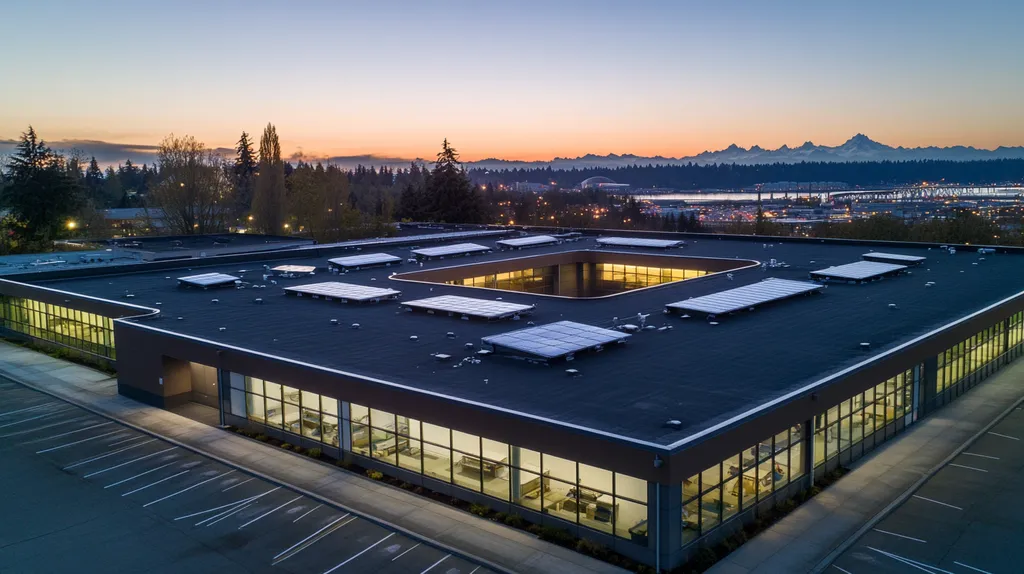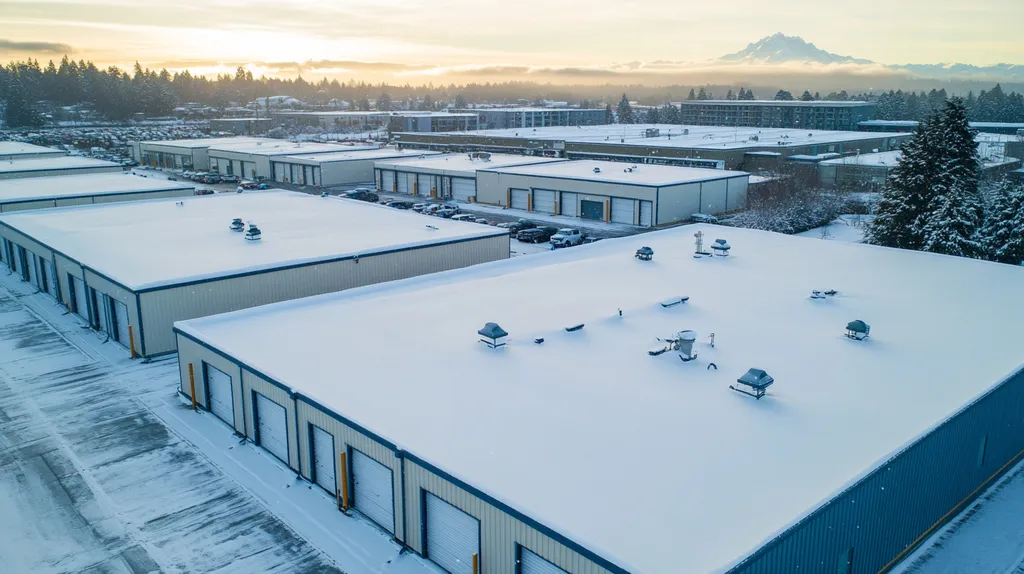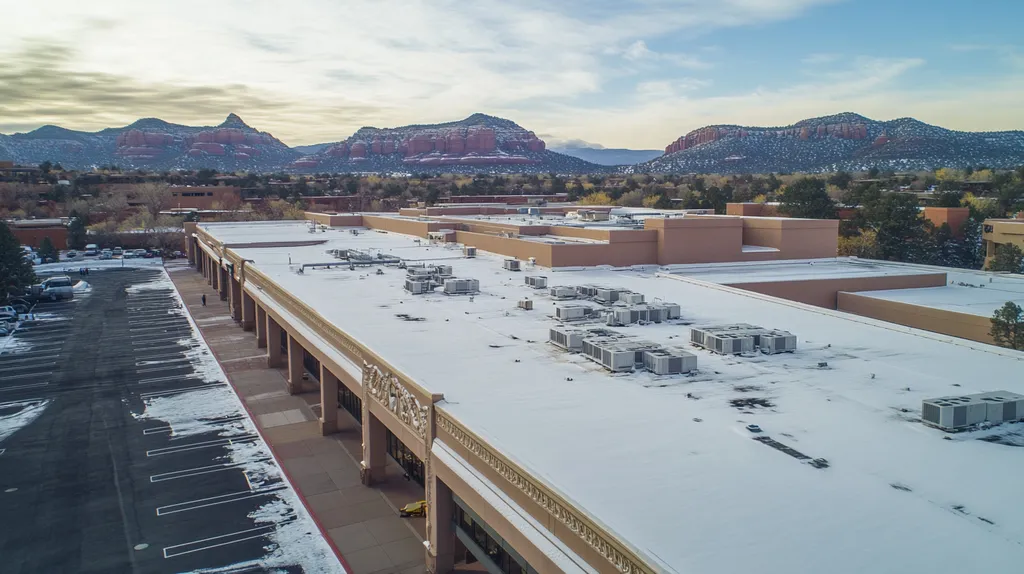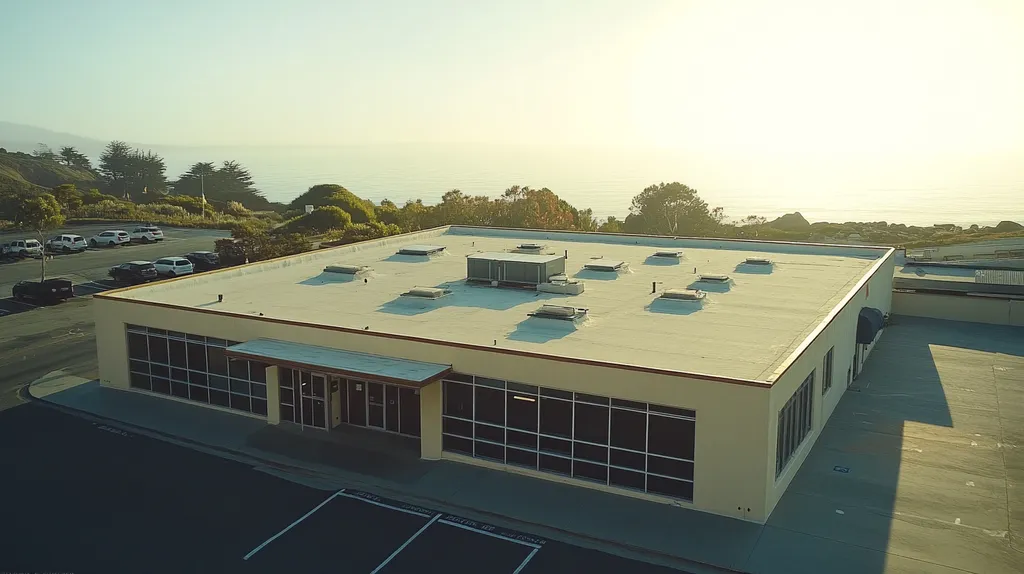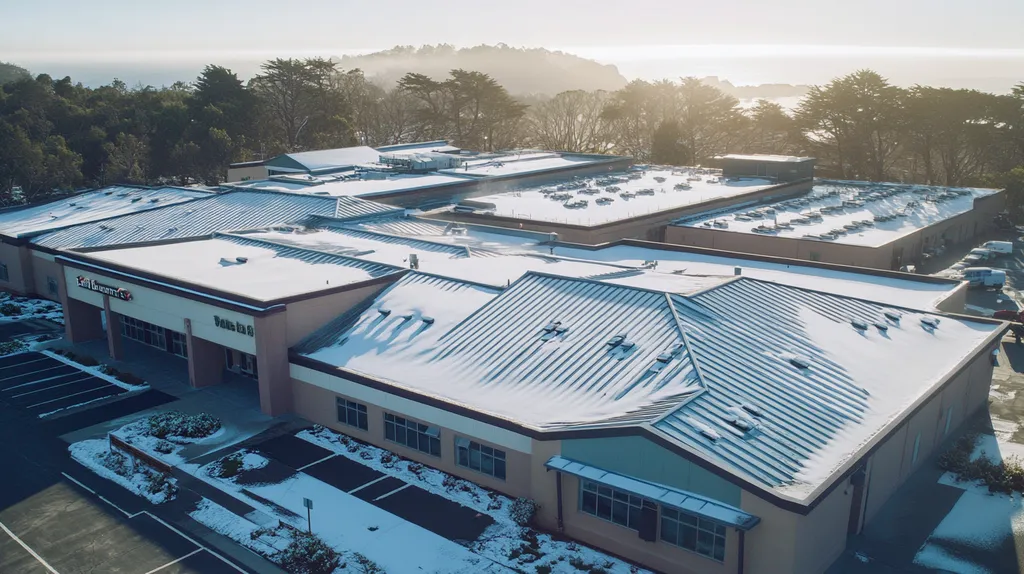Rising energy costs and environmental concerns have pushed commercial building efficiency to the forefront of facility management, with HVAC systems accounting for up to 40% of total energy consumption in commercial buildings.
The relationship between solar energy and HVAC performance represents a critical yet often overlooked factor in achieving optimal energy efficiency for commercial properties.
Understanding how roof design, materials, and solar interaction affect HVAC systems can lead to significant cost savings, with studies showing properly optimized commercial roofs can reduce cooling costs by 15-30% annually.
This comprehensive guide examines the key factors that influence solar effects on HVAC efficiency, providing property owners and facility managers with actionable insights for improving building performance.
SECTION 1: THE BASICS EXPLAINED
Understanding how solar energy affects HVAC efficiency is essential for commercial and industrial property owners. With energy costs on the rise, inefficient HVAC systems can lead to substantial financial burdens. Research indicates that up to 30% of energy consumption in commercial buildings stems from HVAC inefficiencies. Grasping how a roof’s solar performance influences these systems can unlock significant energy savings and enhance overall building efficiency.
What It Is (In Plain Language)
The “solar effect” encompasses how a roof absorbs heat from sunlight, directly impacting the building’s temperature and the efficiency of its HVAC systems. When a roof retains excessive heat, HVAC units are compelled to work harder, spiking energy consumption unnecessarily.
In many commercial environments, flat or low-slope roofs predominate. These types of roofs can become excessively hot on sunny days, which can hinder cooling efficiency. Understanding how solar radiation affects roof temperature allows property managers to make informed choices about roof design and materials.
Furthermore, this knowledge aids in selecting roofing materials, like reflective coatings, that can significantly reduce heat absorption. By making the right choices, property owners can dramatically improve thermal performance.
In summary, a well-optimized roof serves as a protective barrier, facilitating efficient HVAC operation while lowering energy costs.
Why It Matters (To Your Building)
The impact of solar energy on HVAC systems translates directly into operational expenses. Inefficient roofs that fail to reflect heat put undue stress on HVAC systems, leading to increased repair costs and shortened lifespans of these vital systems.
Energy efficiency also ties into the broader goal of building sustainability. Properties showcasing high HVAC efficiency can achieve certifications such as LEED, making them more attractive to tenants and potentially lowering insurance premiums.
Moreover, consider the risk of discomfort during peak summer months. An HVAC system that falters under high demand can result in an uncomfortable indoor environment, threatening tenant satisfaction and productivity.
Investing in roofing solutions that optimize solar efficiency opens the door to considerable financial savings and enhances tenant experience.
How It Works
The interplay between solar heat absorption and HVAC functionality hinges on various factors. Elements such as the roof’s color, material, and slope significantly influence performance. Light-colored, reflective materials can minimize heat absorption, effectively reducing the strain on HVAC systems.
For example, cool roofing systems utilize reflective coatings to lower rooftop temperatures considerably. This, in turn, allows HVAC systems to operate more efficiently, requiring less energy to maintain comfortable indoor environments.
Conversely, dark roofing materials tend to absorb heat, leading to elevated internal building temperatures. Such conditions can cause HVAC systems to run continuously without achieving optimal comfort levels.
Additionally, insulation plays a critical role. A well-insulated roof helps sustain stable indoor temperatures, further improving energy efficiency. When insulation works alongside reflective materials, the benefits multiply.
Ultimately, understanding how these components interact can greatly influence the energy performance of commercial roofs. This knowledge empowers property owners to make informed and effective roofing decisions.
SECTION 2: PRACTICAL APPLICATIONS
The influence of solar energy on HVAC systems is more critical than ever for commercial properties. With the persistent increase in energy costs, optimizing HVAC efficiency through thoughtful roof design and materials can result in significant savings. A study found that reflective roofing can reduce cooling costs by up to 20% in hotter climates. Knowing how to effectively utilize solar impacts can dramatically enhance energy performance, making it imperative for property owners and facility managers to take action.
Common Uses & Examples
Many commercial properties are turning to reflective roofing materials to combat the heat. For example, a warehouse located in a sun-drenched area retrofitted its roof with a cool roof system, resulting in a marked reduction in HVAC operation hours. These roofs excel at reflecting sunlight and minimizing heat absorption, translating into tangible energy savings.
Additionally, the trend toward green roofs is on the rise, which not only provides natural insulation but also contributes to the environment. A shopping center with a vegetated roof saw improved HVAC performance during summer months, gaining both aesthetic and functional benefits.
Moreover, integrating skylights into office buildings optimizes natural light while limiting heat gain. This strategy has been shown to enhance worker productivity, as well as reduce dependence on artificial lighting.
These examples showcase how strategic roofing decisions can lead to impressive improvements in HVAC efficiency and overall energy performance in commercial spaces.
When You Need It Most
Recognizing when to apply these roofing strategies is key to maximizing their benefits. The peak summer months are particularly crucial for HVAC considerations, as energy costs can reach new heights. During this time, commercial roofs face intense pressure from relentless sunlight.
Building owners should also evaluate HVAC needs during periods of building expansion or renovation. Implementing reflective materials during these transformative phases can lay the groundwork for optimized energy performance from the outset.
Geographical climate greatly influences roofing strategies as well. Properties in regions with long stretches of sunny weather or extreme heat require effective roofing solutions more than those in milder climates. Understanding local environmental factors is essential for making necessary roofing adjustments to protect HVAC efficiency.
By being aware of peak times and conditions, property owners can make timely investments in effective roofing systems.
Interactions With Other Systems
A commercial roof’s performance doesn’t operate in a vacuum; it interacts with various building systems. For instance, an energy-efficient roof works hand-in-hand with HVAC units by reducing heat influx into the building. This synergy not only allows HVAC systems to run more efficiently but also extends their lifespan and lowers maintenance costs.
Additionally, integrating solar panels with roofing systems can yield further energy savings. A facility that pairs a solar rooftop with a reflective surface maximizes energy production while simultaneously lessening the burden on HVAC systems. This dual-function approach can greatly enhance a property’s overall energy profile.
Furthermore, the choice of insulation should align with roofing strategies. Effective insulation can amplify the benefits of cool or green roofs, ensuring optimal energy performance throughout all seasons.
Understanding these interactions empowers property owners to maximize the overall efficiency of their buildings, leading to enhanced long-term energy conservation.
SECTION 3: KEY TERMINOLOGY DECODED
In the complex world of commercial roofing, grasping key terminology is not just helpful—it’s essential. Understanding the right terms can pave the way for more effective energy strategies and improved HVAC performance. Concepts related to solar impact, insulation, and thermal dynamics are pivotal during roofing decisions. A clear grasp of these terms can lead to reduced energy expenses and an extended life for roofing systems.
Essential Terms Explained
To start, “solar reflectance” is a vital term. It measures how much sunlight a roof can bounce back, significantly reducing heat absorption. When roofs exhibit higher solar reflectance, they keep the building cooler, decreasing the strain on HVAC systems.
Next, there is “thermal emittance.” This term gauges how much heat a roof releases back into the atmosphere. It works in tandem with solar reflectance to prevent roof surfaces from holding onto surplus heat, which can lead to inefficiencies in HVAC systems.
Another key concept is the “insulation R-value.” This metric indicates a roof’s resistance to heat flow. A roof with a higher R-value provides better insulation, enabling indoor temperatures to be maintained with less energy input.
Grasping these fundamental terms facilitates constructive conversations on optimizing roofing for enhanced HVAC efficiency.
Industry Jargon Translated
The roofing industry is often dense with jargon that can be confusing. For example, “cool roofs” are engineered to reflect more sunlight and absorb less heat compared to standard roofing options. This feature is especially beneficial for minimizing cooling expenses in warmer climates.
“Green roofs” refer to those adorned with vegetation. These roofs not only provide natural insulation but also effectively reduce heat absorption, leading to notable decreases in energy consumption.
Understanding this jargon is crucial for evaluating roofing products and confirming their energy-saving capabilities.
Measurement & Units Simplified
Measurement units are essential when assessing roofing materials. Solar reflectance is typically expressed as a percentage, where higher values indicate superior performance. For instance, a solar reflectance of 60% means that the roof reflects 60% of incoming solar energy.
Thermal emittance is often expressed on a scale from 0 to 1, where a value of 0.9 suggests that 90% of heat is radiated away, ensuring cooler indoor conditions.
In terms of R-values, these are frequently represented in numerical values like 20 or 30. A roof designated with an R-value of 30 will offer increased insulation compared to one with an R-value of 20, directly impacting HVAC efficiency and energy expenditures.
A solid understanding of these measurements empowers property owners to select the most effective roofing materials tailored to their climate and energy requirements.
SECTION 4: DECISION FACTORS
In the face of escalating energy costs, commercial property owners and facility managers must prioritize how roofing materials influence HVAC efficiency. A poorly chosen roofing solution can lead to excessive energy consumption, diminished tenant comfort, and increased operational expenses. For instance, incorporating reflective roofing could reduce HVAC load by up to 15%, underscoring the importance of making informed decisions. This section explores key factors—cost implications, performance trade-offs, and durability considerations—that are vital for achieving optimal energy performance.
Cost Considerations
Understanding the financial implications of roofing materials and installation is essential for effective decision-making. While high-performance roofing systems may require a larger initial investment, they often yield substantial long-term savings through enhanced energy efficiency. For example, cool roofs can significantly lower energy expenses by reducing reliance on air conditioning during hot months.
On the other hand, selecting lower-cost materials might seem appealing initially but can lead to higher HVAC operational costs and frequent replacements. It is crucial for property managers to assess the total cost of ownership to optimize budget allocations.
Additionally, exploring government incentives and rebates for energy-efficient upgrades can alleviate installation costs. Property owners should be proactive in identifying available programs that encourage sustainable roofing solutions.
Taking a lifecycle cost approach, which weighs benefits against expenses over time, allows for a more comprehensive financial analysis. This strategy ensures immediate savings do not come at the expense of long-term energy efficiency.
Performance Trade-offs
When evaluating roofing options, performance trade-offs significantly impact HVAC efficiency. While traditional dark roofing materials may have lower upfront costs, they can absorb excessive heat, compelling HVAC systems to work harder.
In contrast, lighter or reflective roofing materials can reduce surface temperatures and lessen cooling loads. Understanding these trade-offs is essential for optimizing energy consumption and maintaining comfortable indoor environments.
Moreover, factors such as insulation quality and ventilation are critical to overall system effectiveness. A well-insulated roof, combined with suitable materials, creates an energy-efficient synergy that enhances HVAC performance.
Recognizing these performance factors empowers facility managers to select roofing solutions that support their HVAC systems and contribute to a more energy-efficient building.
Lifespan & Durability Factors
The longevity and durability of roofing materials play a pivotal role in HVAC efficiency. A roof that withstands environmental stressors will require less frequent maintenance and replacement, ultimately saving costs over time.
For example, a high-quality thermoplastic polyolefin (TPO) roof can last 20 years or more while retaining its reflective properties and energy efficiency throughout its lifespan. Conversely, lower-quality materials may degrade sooner, leading to premature failures.
A resilient roof also reduces risks such as leaks and moisture buildup, which can adversely affect HVAC performance. Inadequate roofing systems can lead to increased humidity levels, compromising system efficiency and indoor air quality.
Investing in durable roofing solutions can yield significant energy savings and alleviate the burden of costly repairs, allowing for a more predictable operational budget. Therefore, selecting robust roofing materials serves as a strategic approach to ensure long-term HVAC performance.
SECTION 5: COMMON CHALLENGES
Integrating solar energy into commercial roofing systems introduces challenges that can have a profound impact on HVAC efficiency. Ignoring these issues can lead to escalating operational costs and discomfort for building occupants. For example, inadequate management of solar heat gain can effectively double HVAC energy consumption, highlighting the necessity for immediate and proactive solutions. This section identifies common challenges, signals to monitor, and preventative strategies to enhance overall energy performance.
Frequent Problems & Solutions
Inadequate insulation stands as one of the most prevalent issues leading to increased solar heat gain. Effective insulation is vital for limiting heat transfer, thereby supporting HVAC efficiency. Property owners should assess existing insulation and consider upgrading to materials with better R-values to combat this challenge.
Another significant hurdle is the improper placement of solar panels. Panels obstructing roof ventilation can cause overheating, which places additional strain on HVAC systems. Adjusting panel positioning and utilizing reflective materials can help alleviate these overheating issues.
Furthermore, outdated HVAC systems may struggle under the burden of escalating solar intensity. Upgrading to modern, energy-efficient equipment ensures optimal performance and resilience against changing thermal conditions.
Lack of regular maintenance compounds these challenges, enabling issues to worsen over time. Implementing a routine inspection schedule can help identify and rectify potential problems, preserving both roofing integrity and HVAC effectiveness.
Warning Signs To Watch For
Early detection of warning signs is essential for maintaining energy efficiency. A noticeable increase in energy bills often signals rising HVAC activity caused by solar heat gain. A sudden spike, particularly during warmer months, should prompt immediate investigation.
Building occupants frequently report discomfort or inconsistencies in indoor temperatures, which signals that HVAC systems are overcompensating for excessive heat. Investigating the root causes of these complaints is critical to restoring comfort levels.
Physical damage on roof surfaces, such as blistering or warping, serves as another warning indicator of poor material performance under solar exposure. These signs necessitate an evaluation of cooling strategies to address the issue effectively.
Additionally, consistent breakdowns or required repairs of HVAC components indicate that the system is battling increased stress. Monitoring the frequency of repairs offers valuable insights into the need for assessments of system efficiency.
Preventative Approaches
Adopting proactive measures can significantly enhance HVAC performance in conjunction with solar installations. One effective approach is implementing reflective roofing materials, which actively minimize solar heat absorption and help maintain cooler building temperatures.
Regular energy audits provide critical insights into how solar energy affects overall HVAC efficiency. This data-driven methodology allows property owners to pinpoint where improvements can yield the most significant benefits.
Utilizing advanced building management systems optimizes HVAC operations by continuously monitoring indoor conditions and adjusting settings in real time. This creates a responsive environment that maximizes energy savings.
Moreover, investing in landscaping that includes shade-producing trees helps lower rooftop temperatures and reduce the HVAC load. This long-term, environmentally conscious strategy not only saves energy but also enhances the aesthetic appeal of the property.
SECTION 6: NEXT STEPS & RESOURCES
Addressing the impact of solar energy on HVAC efficiency is crucial for commercial property owners and facility managers. Poor roofing decisions can lead to soaring energy costs and reduced equipment lifespan. Engaging knowledgeable providers and leveraging industry standards can help mitigate these issues. This section highlights important inquiries to make, relevant resources to consult, and avenues for further education to enhance energy performance across commercial roofs.
Questions To Ask Providers
When evaluating roofing solutions, asking targeted questions is imperative to uncover a provider’s expertise. Start by inquiring about the materials they recommend for maximum solar reflectance. Providers should be able to explain how their choices will potentially lower HVAC loads and boost energy efficiency.
In addition, request detailed evidence of prior projects that resemble your own. Request data on energy savings achieved post-installation; this serves as a testament to the effectiveness of their proposed solutions.
Warranties are another critical topic; inquire about their terms. Strong warranties reflect confidence in product durability, offering peace of mind for your investment.
Finally, ask about their approach to long-term roof maintenance. A reliable provider should present a clear, actionable plan for ongoing performance upkeep.
Industry Standards & Guidelines
Familiarizing oneself with relevant industry standards is vital for informed decision-making. The Cool Roof Rating Council (CRRC) offers guidelines on solar reflectance and thermal emittance—key factors in energy-efficient roofing systems.
Additionally, the American Society of Heating, Refrigerating and Air-Conditioning Engineers (ASHRAE) sets standards that explore the relationship between building design and HVAC energy performance. These benchmarks aid in determining optimal HVAC system sizes and energy loads.
Resources such as the Energy Star program provide insights into energy-efficient products and best practices. Utilizing these standards ensures compliance while maximizing roof performance.
By leveraging these resources, property owners can make educated decisions that result in significant energy savings.
Further Learning Simplified
For those seeking to deepen their understanding of solar effects on HVAC efficiency, numerous accessible resources are available. Online platforms like the U.S. Department of Energy’s Energy Efficiency and Renewable Energy website offer clear, research-based information.
Webinars and workshops held by roofing associations present opportunities to gain insights directly from industry experts. Engaging in these educational sessions fosters a better grasp of the latest advancements in roofing and HVAC technologies.
Industry publications and newsletters are also valuable; they frequently feature articles about emerging roofing technologies and highlight successful case studies. Staying informed through these resources not only benefits property management but also enhances the overall efficiency and sustainability of commercial buildings.
Looking Ahead
With commercial buildings consuming up to 40% of their energy through HVAC systems, optimizing solar effect on roofing represents a critical opportunity for substantial cost savings and improved building performance.
Studies demonstrate that properly managed solar effects can reduce cooling costs by 15-30% annually, offering an immediate path to enhanced operational efficiency.
The integration of reflective materials, proper insulation, and strategic design choices creates a comprehensive approach to maximizing HVAC performance while minimizing energy waste.
As energy costs continue to rise and environmental regulations tighten, property owners who fail to address solar effects risk increasing operational expenses and declining property values.
The time for implementing effective solar management strategies is now, as tomorrow’s energy challenges demand immediate action.
FREQUENTLY ASKED QUESTIONS
Q. What is the solar effect on commercial roof HVAC efficiency?
A. The solar effect refers to how a roof absorbs heat from sunlight, affecting the building’s temperature and HVAC efficiency. If roofs retain excessive heat, HVAC systems must work harder, increasing energy consumption. By understanding solar performance, property managers can select better roofing materials to improve thermal performance, enhance efficiency, and reduce costs.
Q. How can a commercial roof improve HVAC efficiency?
A. A commercial roof can improve HVAC efficiency through reflective materials that minimize heat absorption, reducing cooling loads. For example, utilizing cool roofing systems can lower operational hours of HVAC units, resulting in significant energy savings. Property owners can also explore green roofs, which offer insulation while enhancing aesthetics.
Q. What does solar reflectance mean for an industrial roof?
A. Solar reflectance measures how much sunlight a roof reflects, which is critical for maintaining lower indoor temperatures. Higher solar reflectance results in reduced heat absorption, directly impacting HVAC efficiency and energy consumption. Choosing roofing materials with high reflectance is key for optimizing performance, especially in industrial settings.
Q. What factors affect HVAC efficiency related to commercial roofs?
A. Several factors affect HVAC efficiency, including roof color, material, and slope. Light-colored, reflective roofing materials help lower temperatures, improving HVAC operation. Also, proper insulation and ventilation enhancements boost overall energy efficiency, ensuring that HVAC systems perform optimally. Each element contributes to the building’s thermal performance and energy costs.
Q. What common challenges affect HVAC efficiency in commercial buildings?
A. Common challenges include inadequate insulation, poor solar heat management, and outdated HVAC systems. These issues can lead to excessive energy consumption and discomfort among occupants. Installing reflective roofing materials, enhancing insulation, and ensuring regular maintenance can mitigate these challenges, promoting better efficiency and lower operational costs.
Q. How can I assess roofing materials’ efficiency for my commercial roof?
A. To assess roofing materials’ efficiency, consider their solar reflectance and thermal emittance ratings. Higher values indicate better performance in regulating heat absorption. It’s also beneficial to evaluate long-term costs, including installation and maintenance. Engage qualified providers to discuss the best options tailored to your specific climate and building needs.
Q. What next steps should I take regarding my industrial roof?
A. Start by evaluating your current roofing system, looking for signs of wear and inefficiency. Consult with roofing professionals about integrating reflective materials and improving insulation. Additionally, educate yourself on industry standards and available resources to ensure informed decisions for optimizing your industrial roof’s energy performance.

